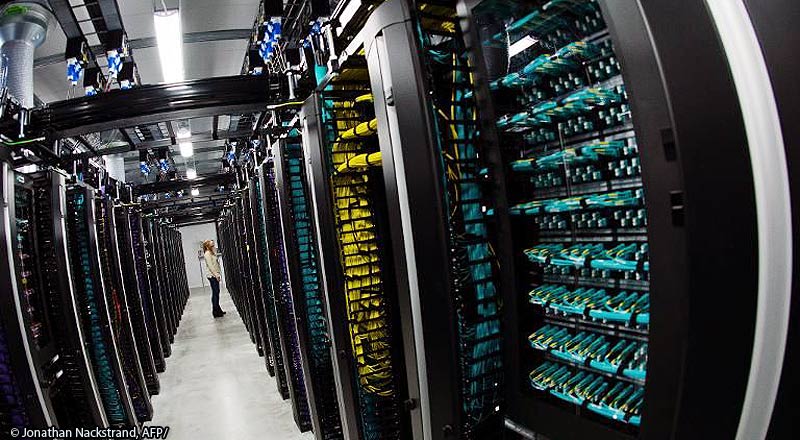Taking down the heat: Liquid cooling for data centres

© Jonathan Nackstrand, AFP
With AI and 5G creeping into use by more and more people, data centres face an important challenge in maintaining efficient cooling systems especially as the demand for computational power continues to rise.
Consequently, traditional air cooling methods, once reliable, are now revealing their limitations, hindering technological progress and environmental sustainability.
Dr. Kelley Mullick, Vice President for Technology Advancement and Alliances at Iceotope Technologies, has been exploring the challenges facing data centres in maintaining efficient cooling systems.
This research compares key liquid cooling technologies. Mullick explains there are “two basic types of liquid cooling technologies: cold plate and immersive, both which are available in single-phase and two-phase processes.”
In terms of market dominance cold plate technology is well established in the market and is the predominant type of liquid cooling used today. A third type of liquid cooling is precision liquid cooling.
In assessing the merits of these different technologies, Mullick finds:
Cold-Plate Cooling
Mullick notes: “Cold-plate cooling is a specialized liquid cooling method that involves the use of cold plates, typically made from metal, to dissipate heat generated by electronic components within IT equipment. The cold plates are strategically designed to come into direct contact with components within the equipment. As the electronic components heat up during operation, the cold plates conduct and absorb the heat, quickly transferring it to the cooling fluid, usually water or a dielectric liquid.”
Furthermore: “The cooling fluid, carrying the absorbed heat, flows through a closed-loop system to a heat exchanger or chiller, where the heat is dissipated into the ambient environment or directed to another cooling system for further heat removal. This continuous cycle of heat absorption and dissipation maintains the desired operating temperatures of the electronic components.”
Mullick adds: “Cold-plate cooling excels in efficient heat transfer by establishing direct contact between the cold plates and heat sources, which minimizes thermal resistance.”
With the downsides, Mullick establishes: “Cold-plate cooling has its limitations. Implementing cold-plate cooling systems can be complex, often necessitating custom designs to accommodate various IT equipment configurations. Cold-plate configurations utilizing rigid metal tubing, such as copper or aluminium, exhibit superior cooling capabilities when compared to other designs. However, this advantage comes at the cost of increased maintenance complexity, because copper or aluminium necessitates meticulous removal for IT equipment access. In the context of high-compute applications like AI, the substantial copper requirements render these setups considerably more expensive than conventional air-cooled systems.”
Immersion Cooling
Immersion cooling submerges entire servers or IT equipment into a specially designed dielectric liquid or coolant. Mullick describes this: “Unlike air cooling or traditional liquid cooling, which rely on air or liquid to indirectly remove heat, immersion cooling enables direct contact between electronic components and the cooling fluid. As the IT equipment operates, it generates heat, which is efficiently transferred to the surrounding coolant. The heated coolant rises to the surface, where it can be directed to a cooling system, such as a heat exchanger, to dissipate the accumulated heat. This continuous cycle maintains the equipment at optimal operating temperatures.”
Precision Liquid Cooling
Precision liquid cooling is an advanced method of cooling high-performance computing systems, by using a carefully controlled flow of dielectric (non-conductive) liquid coolant.
Mullick’s assessment is: “Unlike traditional air cooling, where fans dissipate heat, precision liquid cooling involves direct contact between the liquid coolant and CPUs and GPUs within the hardware. The ability to provide precise, targeted cooling exactly where it’s needed most ensures no overcooling of less heat-intensive parts, which can waste energy and resources.”
In terms of the advantages, Mullick says: “One of the most prominent benefits is the operational cost savings it delivers. By employing precision liquid cooling, data centers can achieve remarkable reductions in their overall operational expenses. But, precision liquid cooling doesn’t just contribute to cost savings; it also plays a pivotal role in conserving water resources.”
He adds: “Through its innovative design and cooling mechanisms, water usage is substantially reduced compared to traditional cooling methods. This reduction in water consumption aligns with the growing focus on sustainability and responsible resource management, making precision liquid cooling an environmentally conscious choice for modern data centers.”
A further benefit is that precision liquid cooling is designed in a familiar chassis-based form factor that seamlessly integrates cooling within the IT equipment, ensuring uniform and efficient cooling across every component within the server blade.
This leads Mullick to outline: “Precision liquid cooling also excels in environments demanding high compute densities, making it a superb choice for edge applications. No specialized training is necessary for servicing IT equipment, and in the event of component failures, quick and seamless hot swapping can be performed right on the data center floor or at edge locations.”
Mullick is of the view that through liquid cooling solutions it is possible to strategically position an organization so that it achieves enhanced operational efficiency, reduces its energy consumption, and meet global sustainability standards.
Taking down the heat: Liquid cooling for data centres
#heat #Liquid #cooling #data #centres




